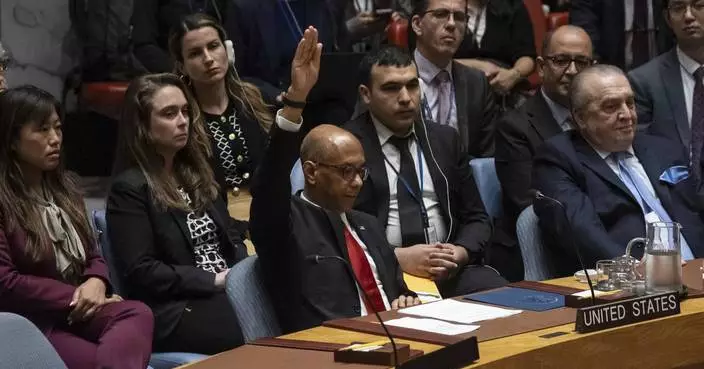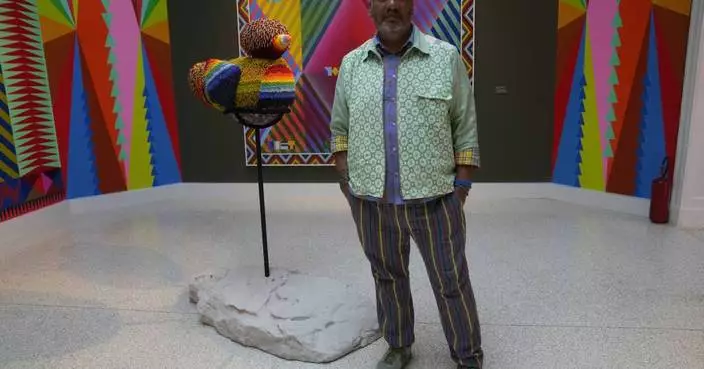Glen Libby looks back fondly on his days as a Maine shrimp trawler, but he's concerned about what seafood lovers will think if the shuttered fishery ever reopens.
"Shrimp? What are those?" he said. "There will be a market. But it depends how big of a market you're talking about."
Maine's historic shrimp industry has been closed since 2013 due to a loss in population of shrimp off of New England that is tied in large part to warming oceans. And with a reopening likely several years away — if it ever happens at all — Libby and others who formerly worked in the business are grappling with how much of the industry they'll be able to salvage if the time ever comes.
The state's shrimp fishery was traditionally a winter industry, but it's in the midst of its sixth straight season with no participation because of a government-imposed moratorium. Fishermen, wholesalers, distributors and others in the seafood business lament the industry wouldn't be in a good position to return right away even if fishing for the little, sweet pink shrimp was allowed.
The region's shrimp are much smaller than those caught in the Gulf of Mexico, which has a much more extensive fishery. Maine's shrimp were essentially a specialty item available fresh only in the winter, though widely available in New England grocery stores.
Maine lacks processing infrastructure for the shrimp now, because that went away when the fishery closed down. The shrimp are largely absent from restaurants and stores, save for some imports from Canada. And the shrimp's brand as a local, wintertime New England delicacy has taken a hit due to years off the market.
If Maine shrimping does come back, it will likely be at a smaller scale, centered on local retail as opposed to freezing the product for export around the country and internationally, said Bert Jongerden, general manager of the Portland Fish Exchange auction house.
"I mean, I think people would remember it. But you couldn't be dumping millions of pounds of shrimp into the market expecting to get rid of it," Jongerden said. "It would have to be a slow build up."
There is no clear timeline for the return of the fishery, because its future is tied to the status of the shrimp population, which looks grim off of New England. Decisions about the future of the fishery are made by an arm of the Atlantic States Marine Fisheries Commission, an interstate body that regulates fisheries. The panel voted in November to extend the fishing moratorium for another three years.
Scientific reports that guide the commission have consistently portrayed the shrimp population as depleted and with poor prospects for the future. The shrimp, which were also brought to land in New Hampshire and Massachusetts, were primarily fished from the Gulf of Maine, a body of water that is warming faster than most of the world's oceans.
Maine shrimpers were mostly fishermen who harvested other fisheries, such as lobsters, scallops and cod, during other parts of the year. The lack of a shrimp season has caused them to lose income or try their luck in other fisheries.
If the fishery does return, part of its appeal could be selling the story of a local New England shrimp fishery to consumers, said Ben Martens, executive director of Maine Coast Fishermen's Association, a fishing advocacy group.
"We would have this slow ramp up where we'd have this delicious, local and highly prized resource, that restaurants, customers and especially local consumers really want," he said.
In the meantime, Canada's shrimp fishery for the same species is still active, but it lacks the brand of the New England-caught product, which long held cachet in Maine and beyond. And Canada's catch has also declined. The country harvested less than 168 million pounds (76 million kilograms) of the shrimp in 2017, less than half the 2010 total and the lowest haul in at least a decade.
Stephenie Pinkham, who was executive director of the Maine Shrimp Trappers Association when it was active, is hopeful. She hears from Mainers that they miss the product, and is confident they'll buy it if the fishery ever reopens.
"A shrimp market is definitely out there," Pinkham said.
TOKYO (AP) — The American envoy to the United Nations called Friday for countries armed with atomic weapons to pursue nuclear disarmament as she visited the atomic bomb museum in Nagasaki, Japan.
Linda Thomas-Greenfield, who became the first U.S. cabinet member to visit Nagasaki, stressed the importance of dialogue and diplomacy amid a growing nuclear threat in the region.
“We must continue to work together to create an environment for nuclear disarmament. We must continue to prevent the spread of nuclear weapons in every corner of the world,” she said after a tour of the atomic bomb museum.
“For those of us who already have those weapons, we must pursue arms control. We can and must work to ensure that Nagasaki is the last place to ever experience the horror of nuclear weapons,” she added, standing in front of colorful hanging origami cranes, a symbol of peace.
The United States dropped the world’s first atomic bomb on Hiroshima on Aug. 6, 1945, destroying the city and killing 140,000 people. A second attack three days later on Nagasaki killed 70,000 more people. Japan surrendered on Aug. 15, ending World War II and its nearly half-century of aggression in Asia.
Nagasaki Gov. Kengo Oishi said in a statement that he believed Thomas-Greenfield's visit and her first-person experience at the museum “will be a strong message in promoting momentum of nuclear disarmament for the international society at a time the world faces a severe environment surrounding atomic weapons.”
Oishi said he conveyed to the ambassador the increasingly important role of Nagasaki and Hiroshima in emphasizing the need of nuclear disarmament.
Thomas-Greenfield's visit to Japan comes on the heels of Prime Minister Fumio Kishida's official visit to the United States last week and is aimed at deepening Washington's trilateral ties with Tokyo and Seoul. During her visit to South Korea earlier this week, she held talks with South Korean officials, met with defectors from North Korea and visited the demilitarized zone.
The ambassador said the United States is looking into setting up a new mechanism for monitoring North Korea's nuclear weapons program. Russia and China have thwarted U.S.-led efforts to step up U.N. sanctions on North Korea over its ballistic missile testing since 2022, underscoring a deepening divide between permanent Security Council members over Russia’s war on Ukraine.
She said it would be “optimal” to launch the new system next month, though it is uncertain if that is possible.
The U.N. Security Council established a committee to monitor sanctions, and the mandate for its panel of experts to investigate violations had been renewed for 14 years until last month, when Russia vetoed another renewal.
In its most recent report, the panel of experts said it is investigating 58 suspected North Korean cyberattacks between 2017 and 2023 valued at approximately $3 billion, with the money reportedly being used to help fund its weapons development.
The United States, Japan and South Korea have been deepening security ties amid growing tension in the region from North Korea and China.
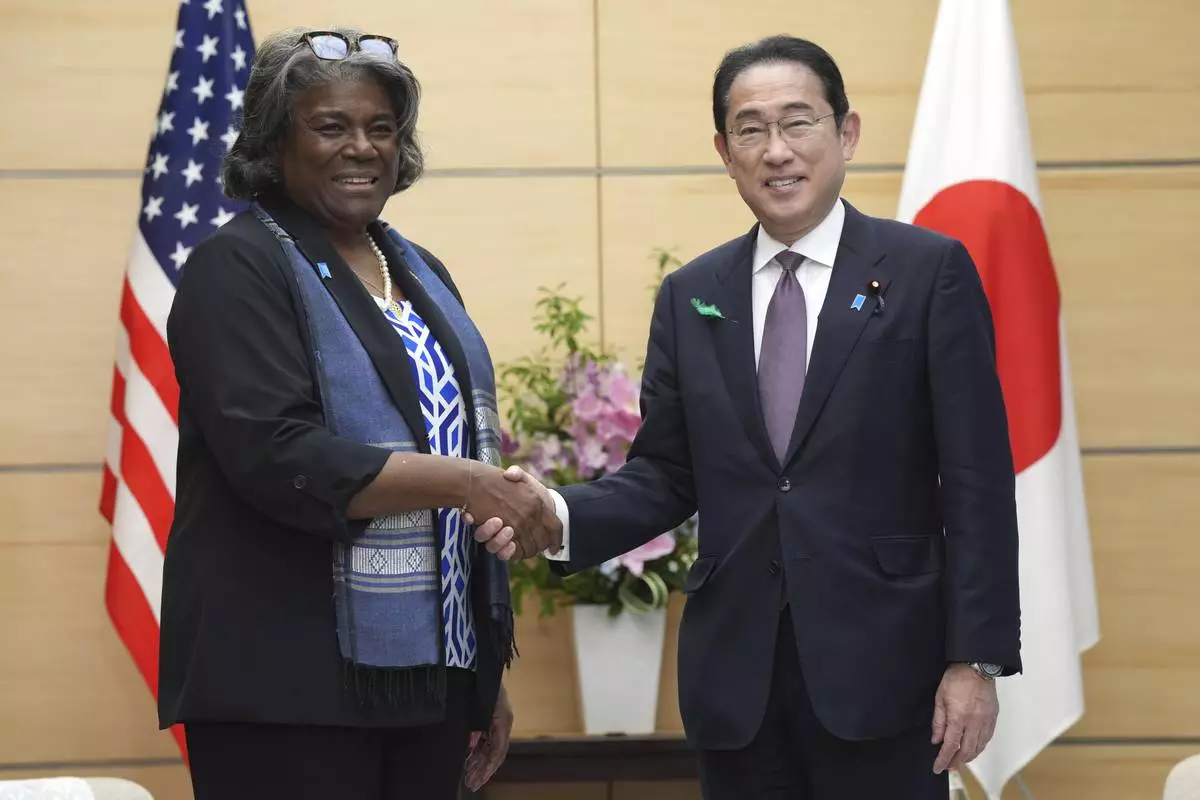
U.S. Ambassador to United Nations Linda Thomas-Greenfield, left, and Japan's Prime Minister Fumio Kishida, right, shake hands during a meeting Friday, April 19, 2024, at prime minister's office in Tokyo. (AP Photo/Eugene Hoshiko, Pool)

U.S. Ambassador to United Nations Linda Thomas-Greenfield, left, and Japan's Prime Minister Fumio Kishida, right, shake hands during a meeting Friday, April 19, 2024, at prime minister's office in Tokyo. (AP Photo/Eugene Hoshiko, Pool)
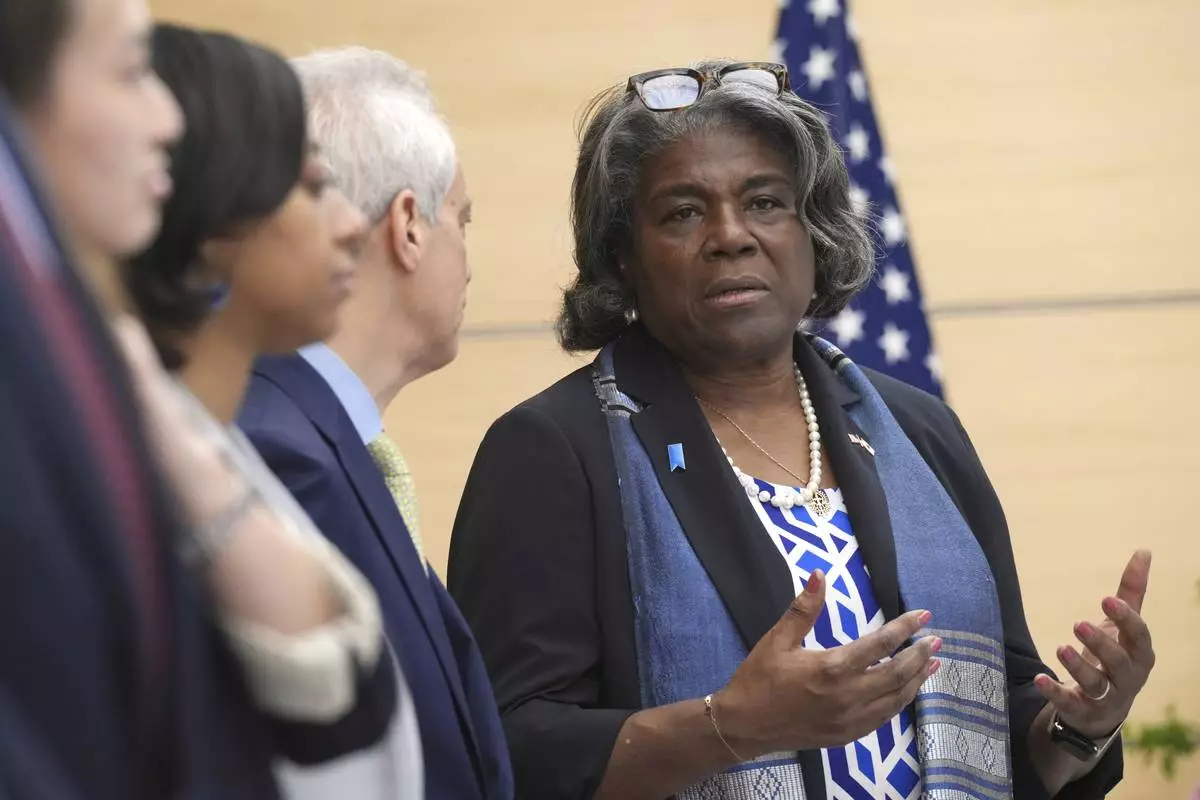
U.S. Ambassador to United Nations Linda Thomas-Greenfield, right, speaks to Rahm Emanuel, U.S. Ambassador to Japan, second right, as they wait for a meeting with Japan's Prime Minister Fumio Kishida Friday, April 19, 2024, at prime minister's office in Tokyo. (AP Photo/Eugene Hoshiko, Pool)
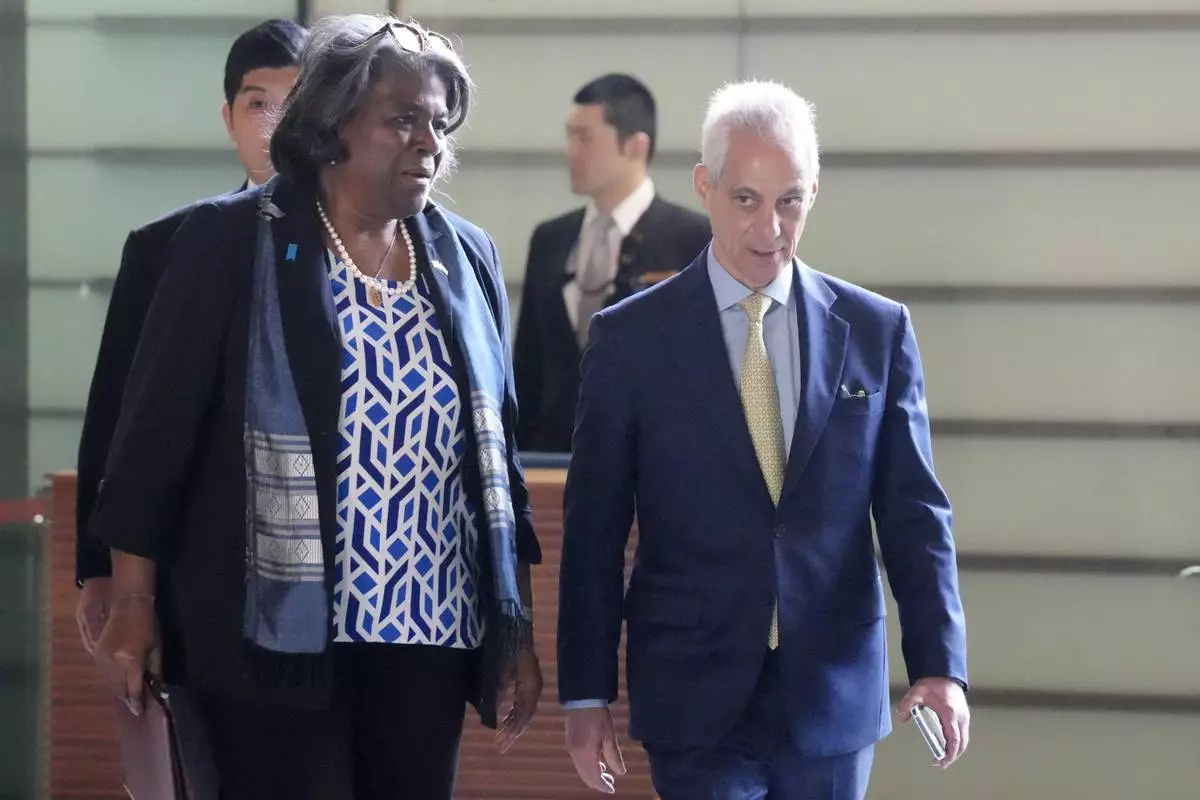
U.S. Ambassador to United Nations Linda Thomas-Greenfield, left, and Rahm Emanuel, U.S. Ambassador to Japan, right, walk to meet Japan's Prime Minister Fumio Kishida Friday, April 19, 2024, at prime minister's office in Tokyo. (AP Photo/Eugene Hoshiko, Pool)
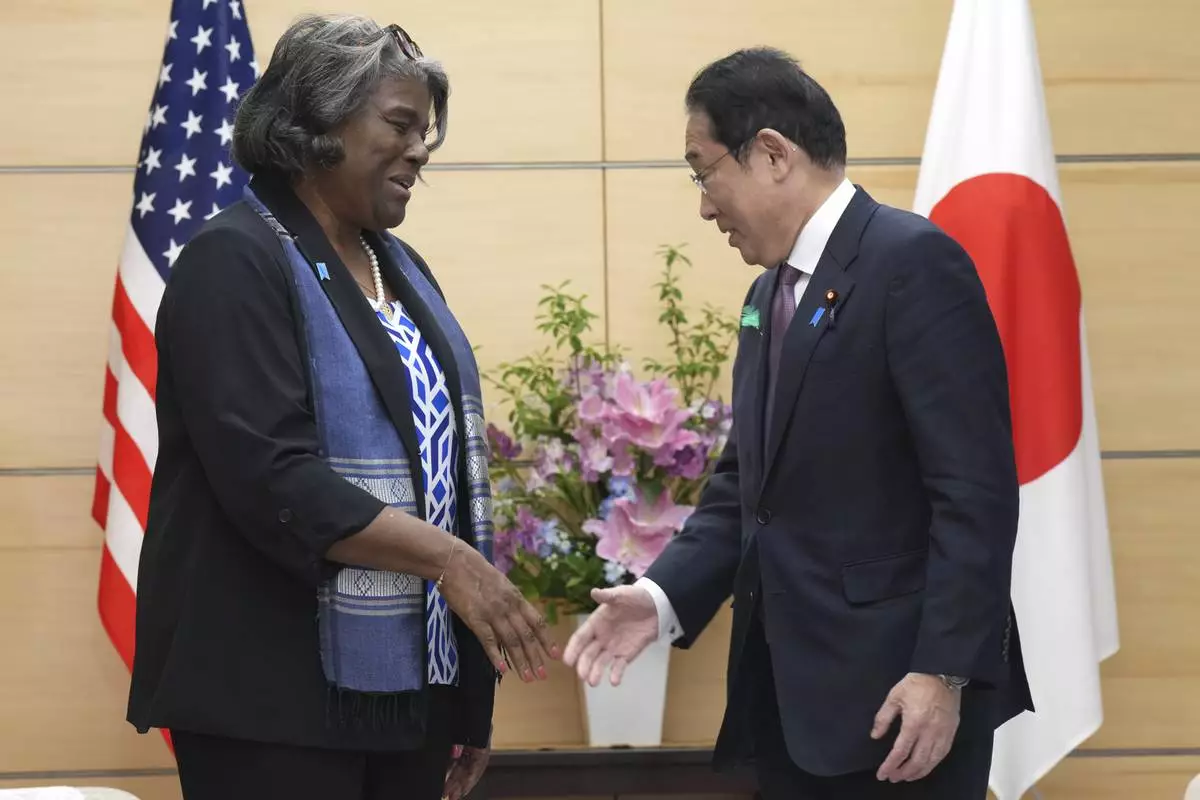
U.S. Ambassador to United Nations Linda Thomas-Greenfield, left, and Japan's Prime Minister Fumio Kishida, right, talk prior to a meeting Friday, April 19, 2024, at prime minister's office in Tokyo. (AP Photo/Eugene Hoshiko, Pool)
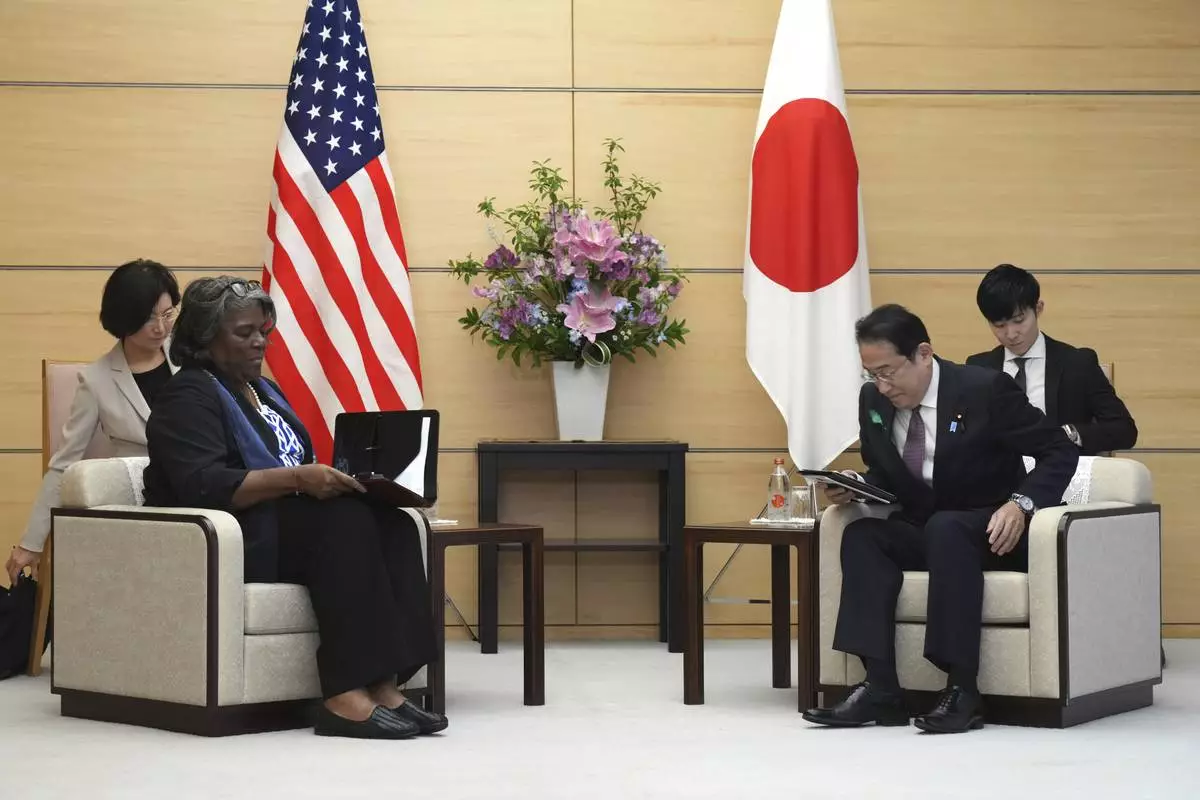
U.S. Ambassador to United Nations Linda Thomas-Greenfield, left, and Japan's Prime Minister Fumio Kishida, right, prepare to talk during a meeting Friday, April 19, 2024, at prime minister's office in Tokyo. (AP Photo/Eugene Hoshiko, Pool)










